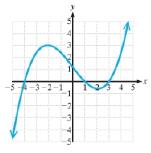Problem 1SP: Use the leading term to determine the end behaviour of the graph of the function.... Problem 2SP: Find the zeros of the function defined by fx=4x34x225x+25. Problem 3SP: Find the zeros of the function defined by fx=x3+10x2+25x. Problem 4SP: Determine the zeros and their multiplicities for the given functions. a.px=35x+345x15b.qx=2x614x4 Problem 5SP: Show that fx=x4+6x326x+15 has a zero on the interval 4,3. Problem 6SP: Graph gx=x3+4x. Problem 7SP: Graph hx=0.5xx1x+32. Problem 1PE: A function defined by fx=anxn+an1xn1+an2xn2++a1x+a0wherean,an1,an2,,a1,a0 are real numbers and an0... Problem 2PE: The function given by fx=3x5+2x+12x (is/is not) a polynomial function. Problem 3PE: The function given by fx=3x5+2x+2x (is/is not) a polynomial function. Problem 4PE: A quadratic function is a polynomial function of degree . Problem 5PE: A linear function is a polynomial function of degree . Problem 6PE: The values of x in the domain of a polynomial function f for which fx=0 are called the of the... Problem 7PE: What is the maximum number of turning points of the graph of fx=3x64x55x4+2x2+6? Problem 8PE: If the graph of a polynomial function has 3 turning points, what is the minimum degree of the... Problem 9PE: If c is a real zero of a polynomial function and the multiplicity is 3, does the graph of the... Problem 10PE: If c is a real zero of a polynomial function and the multiplicity is 6, does the graph of the... Problem 11PE Problem 12PE: What is the leading term of fx=13x343x+52? Problem 13PE Problem 14PE: For Exercises 13-20, determine the end behavior of the graph of the function. (See Example 1)... Problem 15PE: For Exercises 13-20, determine the end behavior of the graph of the function. (See Example 1)... Problem 16PE: For Exercises 13-20, determine the end behavior of the graph of the function. (See Example 1)... Problem 17PE Problem 18PE: For Exercises 13-20, determine the end behavior of the graph of the function. (See Example 1)... Problem 19PE: For Exercises 13-20, determine the end behavior of the graph of the function. (See Example 1)... Problem 20PE: For Exercises 13-20, determine the end behavior of the graph of the function. (See Example 1)... Problem 21PE: Given the function defined by gx=3x13x+54, the value 1 is a zero with multiplicity and the value 5... Problem 22PE: Given the function defined by hx=12x5x+0.63, the value 0 is a zero with multiplicity and the value... Problem 23PE: For Exercises 23-38, find the zeros of the function and state the multiplicities. (See Example 2-4)... Problem 24PE: For Exercises 23-38, find the zeros of the function and state the multiplicities. (See Example 2-4)... Problem 25PE: For Exercises 23-38, find the zeros of the function and state the multiplicities. (See Example 2-4)... Problem 26PE: For Exercises 23-38, find the zeros of the function and state the multiplicities. (See Example 2-4)... Problem 27PE: For Exercises 23-38, find the zeros of the function and state the multiplicities. (See Example 2-4)... Problem 28PE Problem 29PE: For Exercises 23-38, find the zeros of the function and state the multiplicities. (See Example 2-4)... Problem 30PE: For Exercises 23-38, find the zeros of the function and state the multiplicities. (See Example 2-4)... Problem 31PE: For Exercises 23-38, find the zeros of the function and state the multiplicities. (See Example 2-4)... Problem 32PE Problem 33PE: For Exercises 23-38, find the zeros of the function and state the multiplicities. (See Example 2-4)... Problem 34PE: For Exercises 23-38, find the zeros of the function and state the multiplicities. (See Example 2-4)... Problem 35PE: For Exercises 23-38, find the zeros of the function and state the multiplicities. (See Example 2-4)... Problem 36PE Problem 37PE: For Exercises 23-38, find the zeros of the function and state the multiplicities. (See Example 2-4)... Problem 38PE: For Exercises 23-38, find the zeros of the function and state the multiplicities. (See Example 2-4)... Problem 39PE Problem 40PE: For Exercises 39-40, determine whether the intermediate value theorem guarantees that the function... Problem 41PE: For Exercises 41-42, a table of values is given for Y1=fx. Determine whether the intermediate value... Problem 42PE: For Exercises 41-42, a table of values is given for Y1=fx. Determine whether the intermediate value... Problem 43PE: Given fx=4x38x225x+50, a. Determine if f has a zero on the interval 3,2. b. Find a zero of f on the... Problem 44PE Problem 45PE: For Exercises 45-52, determine if the graph can represent a polynomial function. If so. Assume that... Problem 46PE Problem 47PE: For Exercises 45-52, determine if the graph can represent a polynomial function. If so. Assume that... Problem 48PE Problem 49PE: For Exercises 45-52, determine if the graph can represent a polynomial function. If so. Assume that... Problem 50PE Problem 51PE: For Exercises 45-52, determine if the graph can represent a polynomial function. If so. Assume that... Problem 52PE: For Exercises 45-52, determine if the graph can represent a polynomial function. If so. Assume that... Problem 53PE Problem 54PE: For Exercises 53-58, a. Identify the power function of the form y=xn that is the parent function to... Problem 55PE: For Exercises 53-58, a. Identify the power function of the form y=xn that is the parent function to... Problem 56PE Problem 57PE: For Exercises 53-58, a. Identify the power function of the form y=xn that is the parent function to... Problem 58PE Problem 59PE: For Exercises 59-76, sketch the function. (See Example 6-7) fx=x35x2 Problem 60PE: For Exercises 59-76, sketch the function. (See Example 6-7) gx=x52x4 Problem 61PE Problem 62PE: For Exercises 59-76, sketch the function. (See Example 6-7) hx=14x1x4x+2 Problem 63PE: For Exercises 59-76, sketch the function. (See Example 6-7) kx=x4+2x38x2 Problem 64PE: For Exercises 59-76, sketch the function. (See Example 6-7) hx=x4x36x2 Problem 65PE: For Exercises 59-76, sketch the function. (See Example 6-7) kx=0.2x+22x43 Problem 66PE: For Exercises 59-76, sketch the function. (See Example 6-7) mx=0.1x32x+13 Problem 67PE Problem 68PE Problem 69PE: For Exercises 59-76, sketch the function. (See Example 6-7) tx=x4+11x228 Problem 70PE Problem 71PE: For Exercises 59-76, sketch the function. (See Example 6-7) gx=x4+5x24 Problem 72PE: For Exercises 59-76, sketch the function. (See Example 6-7) hx=x4+10x29 Problem 73PE: For Exercises 59-76, sketch the function. (See Example 6-7) cx=0.1xx24x+23 Problem 74PE Problem 75PE: For Exercises 59-76, sketch the function. (See Example 6-7) mx=110x+3x3x+13 Problem 76PE: For Exercises 59-76, sketch the function. (See Example 6-7) fx=110x1x+3x42 Problem 77PE: For Exercises 77-88, determine if the statement is true or false. If a statement is false, explain... Problem 78PE: For Exercises 77-88, determine if the statement is true or false. If a statement is false, explain... Problem 79PE: For Exercises 77-88, determine if the statement is true or false. If a statement is false, explain... Problem 80PE: For Exercises 77-88, determine if the statement is true or false. If a statement is false, explain... Problem 81PE: For Exercises 77-88, determine if the statement is true or false. If a statement is false, explain... Problem 82PE: For Exercises 77-88, determine if the statement is true or false. If a statement is false, explain... Problem 83PE: For Exercises 77-88, determine if the statement is true or false. If a statement is false, explain... Problem 84PE: For Exercises 77-88, determine if the statement is true or false. If a statement is false, explain... Problem 85PE: For Exercises 77-88, determine if the statement is true or false. If a statement is false, explain... Problem 86PE: For Exercises 77-88, determine if the statement is true or false. If a statement is false, explain... Problem 87PE: For Exercises 77-88, determine if the statement is true or false. If a statement is false, explain... Problem 88PE: For Exercises 77-88, determine if the statement is true or false. If a statement is false, explain... Problem 89PE: A rocket will carry a communications satellite into low Earth orbit. Suppose that the thrust during... Problem 90PE: Data from a 20-yr study show the number of new AIDS cases diagnosed among 20- to 24-yr-olds in the... Problem 91PE: Given a polynomial function defined by y=fx, explain how to find the x-intercepts. Problem 92PE: Given a polynomial function, explain how to determine whether an x-intercept is a touch point or a... Problem 93PE Problem 94PE Problem 95PE: Use this broader statement of the intermediate value theorem for Exercises 95-96. Given fx=x23x+2,... Problem 96PE: Use this broader statement of the intermediate value theorem for Exercises 95-96. Given fx=x24x+3,... Problem 97PE: For a certain individual the volume (in liters) of au in the lungs during a 4.5-sec respiratory... Problem 98PE: The torque (in ft-lb) produced a certain automobile engine turning at x thousand revolutions per... Problem 99PE: A solar oven is to be made from an open box with reflective sides. Each box is made from a 30-in. by... Problem 100PE: For Exercises 100-101, two viewing windows are given for the graph of y=fx. Choose the window that... Problem 101PE: For Exercises 100-101, two viewing windows are given for the graph of y=fx. Choose the window that... Problem 102PE: For Exercises 102-103, graph the function defined by y=fx on an appropriate viewing window.... Problem 103PE: For Exercises 102-103, graph the function defined by y=fx on an appropriate viewing window.... format_list_bulleted



 College Algebra (MindTap Course List)AlgebraISBN:9781305652231Author:R. David Gustafson, Jeff HughesPublisher:Cengage Learning
College Algebra (MindTap Course List)AlgebraISBN:9781305652231Author:R. David Gustafson, Jeff HughesPublisher:Cengage Learning Big Ideas Math A Bridge To Success Algebra 1: Stu...AlgebraISBN:9781680331141Author:HOUGHTON MIFFLIN HARCOURTPublisher:Houghton Mifflin Harcourt
Big Ideas Math A Bridge To Success Algebra 1: Stu...AlgebraISBN:9781680331141Author:HOUGHTON MIFFLIN HARCOURTPublisher:Houghton Mifflin Harcourt

 Trigonometry (MindTap Course List)TrigonometryISBN:9781337278461Author:Ron LarsonPublisher:Cengage Learning
Trigonometry (MindTap Course List)TrigonometryISBN:9781337278461Author:Ron LarsonPublisher:Cengage Learning College AlgebraAlgebraISBN:9781305115545Author:James Stewart, Lothar Redlin, Saleem WatsonPublisher:Cengage Learning
College AlgebraAlgebraISBN:9781305115545Author:James Stewart, Lothar Redlin, Saleem WatsonPublisher:Cengage Learning




